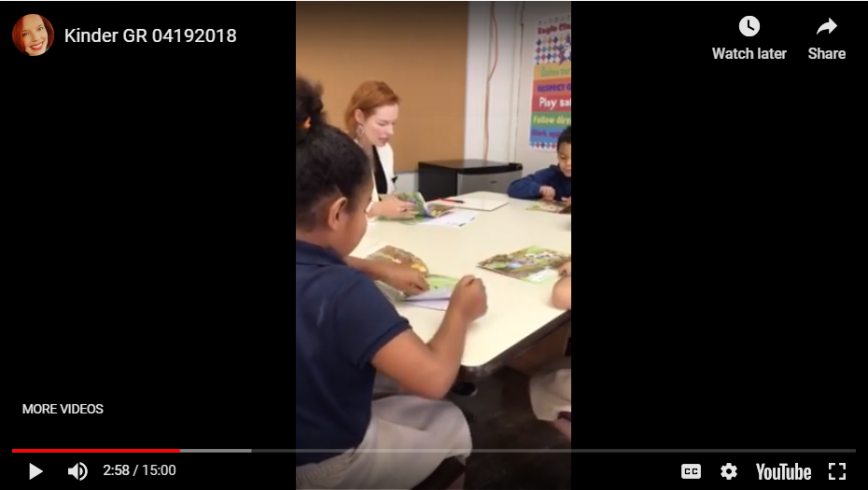The first page of Marie Clay’s 2005 edition of Literacy Lessons Designed for Individuals, Part Two, includes a quote by Dr. Larry Squire that begins with this statement: “You relate what you hear or see to things you already understand.” Above this statement, I wrote, “Bring the book into the child’s world.” This, to me, is what the book introduction prior to the reading of a new text is all about.
Both times I trained as a Reading Recovery© teacher, the book introduction was given high priority and a lot of attention, more so than I have seen since. Kay Brickley and Polly Wingate, my teacher leaders, devoted time to it during every weekly class session. We built discussions around it while watching behind-the-glass lessons and debriefing afterward. So, I understood what a crucial piece of the guided reading lesson it was. Clay (2005) said, “…it helps if the child knows what the story is about before he reads it” (p. 91). Many times we hear about having children do a “picture walk.” While some have written about its effectiveness (Stahl, 2008), Clay asserted, “Descriptions of a ‘picture walk’ in the literature of early literacy do not provide a suitable substitute for the [book] introduction…” (p. 92). Briggs and Forbes (2009) expanded on this statement in an article written for The Reading Teacher journal titled, “Orientation to a New Book: More Than a Picture Walk.” I attended a session by Diane DeFord at a conference once that changed my approach to and my thinking about the book introduction. She agreed with Clay that the teacher and children should not always go page-by-page through a book – that it needs to be more about the possibilities of the book embedded in an authentic conversation.
A colleague and I recently conducted a study of preservice teachers’ guided reading lessons where we observed and audio-recorded their book introductions and debriefed with them after their lessons. We found the picture walk to be ubiquitous, both in their lessons and when they described to us what a book introduction should look like.
So why is the introduction such a pivotal piece of the guided reading lesson? In essence, we are teaching children how to go about orienting themselves to a new piece of literature, a skill that they will need always. Most importantly, we are providing a scaffold to readers to “prepare the child for correct responding on the first encounter” with the text (Clay, 2005, p. 91). The children’s first reading of a text will give us indication of not only their current processing system, but will also reflect the success (or not) of our introduction to the text.
What is the purpose of a book introduction? In addition to the reasons discussed above, my first and foremost goal is to “hook” my readers! I want to do such a fabulous job introducing the book that the children can’t wait to get their hands on it and start reading! Fountas and Pinnell (2017) wrote that “the goal is to interest students in the story, relate it to their experiences, and provide a frame of meaning that will support independent problem solving” (p. 14).
What should we include in a book introduction? It depends! First off, read the text carefully! Book introductions should be tailored to the children who will be reading the book. So, even if you use the same book several times per year for different groups of children, the book introduction will vary. The teacher is to first consider “the best ways to orient [these children] to this book” (Clay, 2005, p. 91) and how to effectively approach taking “the ‘bugs’ out” in order to make the text accessible to the children (p. 91). My Reading Recovery teacher leaders provided me with a helpful way of thinking about planning this part of the lesson. Since we analyze miscues on running records by looking at the cueing systems (how the children use meaning, structure, and visual information), it makes sense to structure the book introduction this way. Consider the following:
- Meaning: story, plot, gist, topic;
- Structure: tricky book language and phrases; how this book works; and
- Visual: new words, known words, partially known words.
Writing the book introduction in this manner helped me to make sure I was addressing each cueing system I could then think about my reader or readers and consider where I wanted to place more emphasis (e.g., do these readers need more support with meaning or with visual information?). Fountas and Pinnell (2017) suggest placing sticky notes in your copy of the text that mark places where you might want to stop and chat. Book introductions are not lengthy; they are engaging and supportive.
Book introductions can be likened to a dance, where the teacher moves up or down in level of support depending on the readers and the level of text complexity for those particular readers. It’s a matter of providing just the right amount of support in each of the cueing systems mentioned above. Of course, knowing what the right amount is depends on knowing our children as readers. Fountas and Pinnell (2017) reminded us that, “The introduction [to the book] is always constructed with the readers in mind” (p. 111, emphasis mine). Teachers are to give careful consideration to the following questions:
- What do readers need to know how to do at this text level?
- What do my readers already know how to do and what are they ready to learn next?
- What do I know about this text?
- What about this text might be challenging for my readers?
- What will I tell them that will support them while still giving them room to engage in some problem-solving?
How do we know when we’ve provided just the right amount of support? Clay (2005) said we shouldn’t have to make a lot of “rescue moves” while children are reading the text if the book introduction is robust. Patterns gleaned from anecdotal notes and running records are extremely helpful guides for writing book introductions.
Here are links to two YouTube videos of guided reading book introductions. In the first one, I use the book Stone Soup (Red Rocket Readers, F&P Level K) with a group of second-grade children. Here, I describe the folktale genre, provide the gist of the story, and show some of the illustrations. I also invite the children to look at the pictures and comment on them. I then review a tricky structure part, “Is it ready yet?” by having the children rehearse it.
The second one uses the book Busy Buddy (Red Rocket Readers, F&P Level D) with a group of kindergarten children. I show them the cover, give them the gist of the story, and discuss the meaning of the word “busy” as it relates to the story. We then discuss how busy Buddy (the dog) is in the book by commenting on the illustrations. I have the students practice a tricky text structure (“run after”); locate the known words likes and he; and predict and locate the partially known word get.
There is an art to writing and delivering book introductions, and with practice (and some acting skills!), each one can be a way to bring a book into a child’s world.
Happy reading!
References
Briggs, C., & Forbes, S. (2009). Orientation to a new book: More than a picture walk. The Reading Teacher, 62(8), 706-709.
Clay, M.M. (2005). Literacy lessons designed for individuals: Part two: Teaching procedures. Portsmouth, NH: Heinemann.
Dougherty Stahl, K.A. (2008). The effects of three instructional methods on the reading comprehension and content acquisition of novice readers. Journal of Literacy Research, 40, 359-393.
Fountas, I.C., & Pinnell, G.S. (2017). Guided reading: Responsive teaching across the grades (2nd ed.). Portsmouth, NH: Heinemann.
Like what we've got to say? Spread the word!

